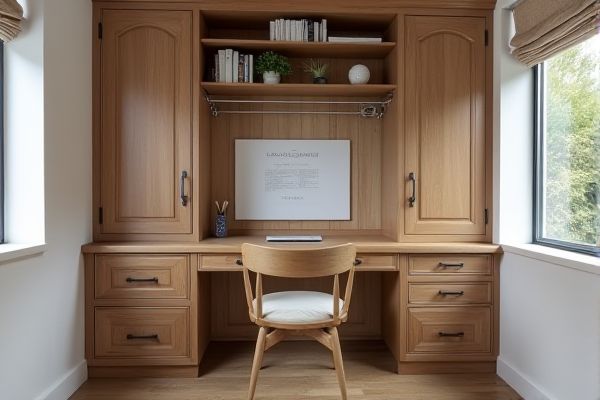
A Murphy desk maximizes space by folding vertically against the wall, ideal for rooms with limited floor area, while a fold-down desk usually mounts horizontally and is perfect for occasional use or compact workstations. Discover which option suits your lifestyle best by exploring the detailed features and benefits in the rest of the article.
Table of Comparison
| Feature | Murphy Desk | Fold-Down Desk |
|---|---|---|
| Design | Wall-mounted, folds vertically into a cabinet or bed frame | Wall-mounted or free-standing, folds horizontally against the wall |
| Space Saving | Maximizes space by hiding completely within walls or closets | Good space saver, folded flat against the wall |
| Installation | Requires secure wall mounting, often professional installation | Simple wall mounting; easier to install |
| Weight Capacity | Supports heavier loads with sturdy frame | Typically lighter load capacity |
| Usage Frequency | Ideal for occasional use or multi-purpose rooms | Better for frequent use and quick setup |
| Price | Generally higher due to complex design and installation | More affordable and budget-friendly |
| Aesthetic | Seamless integration, often blends with wall decor | Visible when folded, more utilitarian look |
Introduction to Murphy Desks and Fold-Down Desks
Murphy desks and fold-down desks both maximize space by folding against walls when not in use, ideal for compact areas. Murphy desks typically incorporate a vertical cabinet design that conceals the workspace, while fold-down desks often feature a horizontal surface that drops down from a mounted panel. Both options offer functional solutions for small living spaces or home offices needing efficient storage and workspace flexibility.
Defining Features: Murphy Desks Explained
Murphy desks are wall-mounted workstations that fold vertically into cabinets or wall units, saving floor space while maintaining a clean, organized look. Unlike fold-down desks, which typically hinge horizontally and rest on brackets or legs when open, Murphy desks often incorporate full cabinetry to conceal office supplies and equipment when closed. Their defining feature is seamless integration into living spaces, combining functionality with aesthetic appeal through built-in storage and compact design.
Understanding Fold-Down Desks
Fold-down desks, also known as wall-mounted desks, are space-saving pieces of furniture that fold flat against the wall when not in use, making them ideal for small rooms or multifunctional spaces. Unlike Murphy desks, which typically fold down from the wall and may include a bed or other integrated furniture, fold-down desks focus solely on providing a compact, ergonomic workspace. These desks often feature built-in storage compartments, efficient cable management, and durable hinges to ensure stability and usability.
Space-Saving Benefits Compared
Murphy desks maximize space by folding vertically against the wall, freeing up floor area when not in use, ideal for small rooms or multi-purpose spaces. Fold-down desks offer similar space-saving advantages but typically fold horizontally, making them easier to install in tighter niches or cabinets. Both designs improve room functionality, but Murphy desks often provide larger work surfaces while fold-down desks excel in compactness and quick access.
Installation and Setup Differences
Murphy desks require wall mounting with robust anchors and studs to support the weight and ensure stability, often involving professional installation for precise alignment. Fold-down desks typically feature simpler wall brackets that allow for quicker, DIY-friendly setup with minimal hardware. The complexity of Murphy desk installation is higher due to integrated mechanisms and heavier construction compared to the straightforward, lightweight design of fold-down desks.
Style and Design Options
Murphy desks offer sleek, space-saving designs that seamlessly integrate into walls, with a variety of contemporary and traditional finish options to match diverse interior styles. Fold-down desks typically provide more rustic or casual aesthetics, often crafted from solid wood or metal, emphasizing practicality with versatile mounting solutions. Both styles come in customizable sizes and finishes, allowing users to select options that best complement their existing room decor.
Practical Uses in Home Offices
Murphy desks maximize space by folding up against the wall, ideal for small home offices where floor space is limited. Fold-down desks offer easy access and can be mounted at various heights, providing ergonomic flexibility for tasks like writing or computer work. Your choice depends on whether you prioritize saving room or quick setup in a multifunctional workspace.
Durability and Materials
Murphy desks typically feature robust hardwood or plywood construction with high-quality hardware, ensuring long-lasting durability and resistance to daily wear. Fold-down desks often use lighter materials such as MDF or particleboard, which may be less sturdy but allow for easier installation and flexibility in small spaces. Choosing between the two depends on the need for durability, with Murphy desks offering stronger structural integrity for frequent use.
Price Comparison and Value
Murphy desks generally come with a higher price tag due to their complex mechanisms and space-saving design, often ranging from $400 to $1,200, while fold-down desks tend to be more affordable, typically priced between $100 and $400. The value of a Murphy desk lies in its ability to maximize vertical space and offer a sturdy, multi-functional workspace, ideal for small rooms or apartments. Your choice depends on budget constraints and the importance of maximizing floor space versus immediate cost savings.
Choosing the Right Desk for Your Space
When choosing the right desk for your space, consider a Murphy desk for its space-saving vertical design that folds up into the wall, ideal for small rooms or multifunctional areas. A fold-down desk offers a similar compact solution but typically mounts to a wall and folds down horizontally, providing a convenient workspace that clears away quickly. Your decision should balance room size, desired functionality, and how often you need to use the desk.
 homyna.com
homyna.com